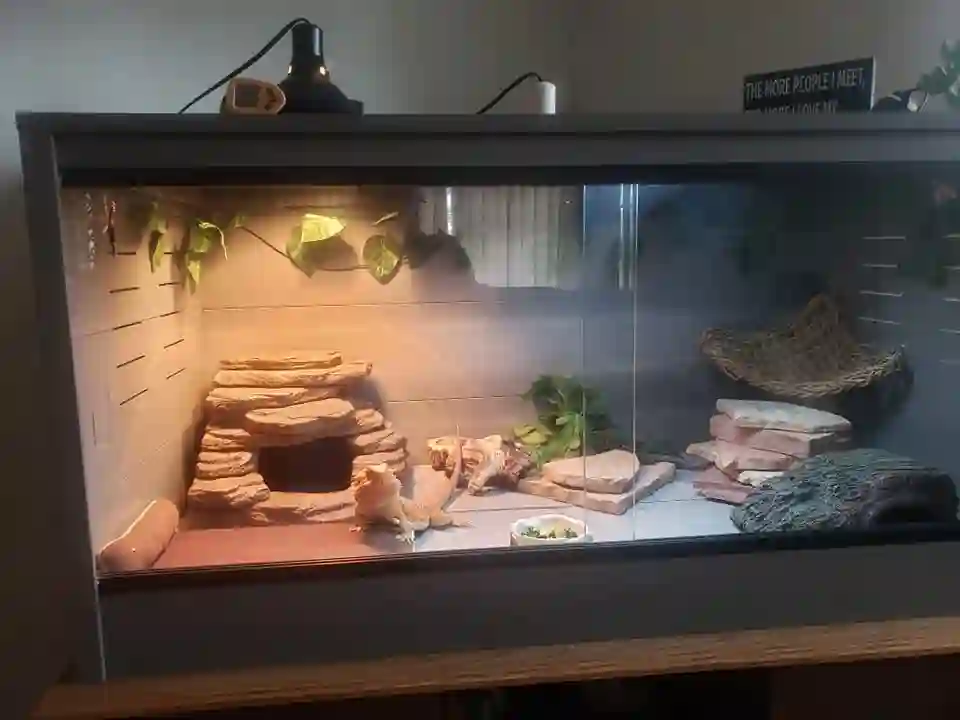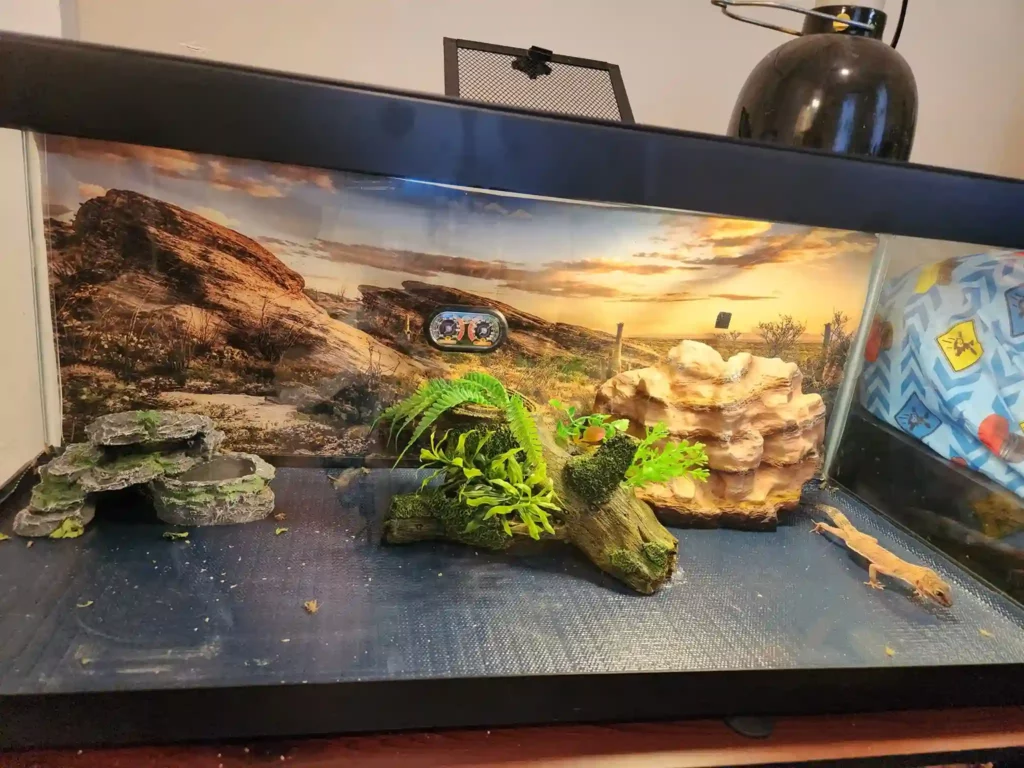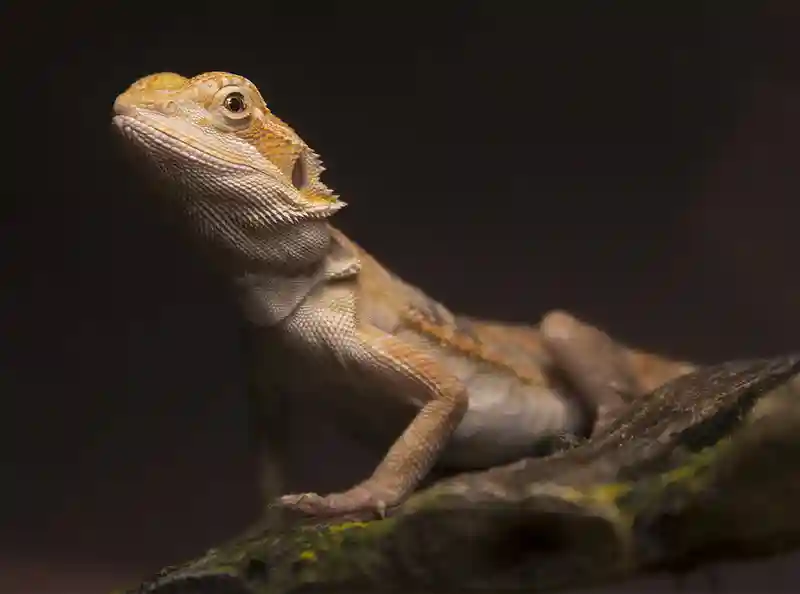A 150-watt bulb is generally not too much for a bearded dragon, as it is a common choice for heating their habitat.
However, the wattage of the bulb should be based on the size of the enclosure. For a bearded dragon heated with a 150-watt bulb, the enclosure should be no larger than 18″x24″x12″12.
You just need to monitor the temperatures of the enclosure to ensure that the habitat stays within a suitable temperature range for the dragon.
If you find that the 150-watt bulb is not providing the appropriate temperatures, you may need to adjust the wattage or the setup of the enclosure.
Understanding Heat Requirements

Ideal Temperature Range
A bearded dragon’s enclosure should have a temperature gradient, with a cooler end and a warmer basking spot. The cool end should be around 75-85°F (24-29°C), while the basking spot should be between 95-110°F (35-43°C).
Basking Spot Temperature
The basking spot is crucial for bearded dragons as it helps them thermoregulate their body temperature, digest food, and synthesize vitamin D. A basking spot that’s too hot or too cold can cause health issues.
Nighttime Temperature
At night, the temperature in the enclosure should drop to around 65-75°F (18-24°C). This drop mimics their natural habitat and helps regulate their metabolism.
150-Watt Bulb: Pros and Cons

Advantages
A 150-watt bulb can create a basking spot with the necessary high temperature. It may be suitable for larger enclosures or rooms with lower ambient temperatures.
Disadvantages
A 150-watt bulb can be too hot for a bearded dragon in a smaller enclosure or a room with a higher ambient temperature. It can cause burns, dehydration, and other health issues if not monitored properly.
Alternatives to 150-Watt Bulbs

Lower Wattage Bulbs
Lower wattage bulbs, such as 50, 75, or 100 watts, may be more suitable for smaller enclosures. They can still create a proper temperature gradient without overheating the enclosure.
Ceramic Heat Emitters
Ceramic heat emitters (CHEs) are a great option for providing heat without emitting light. They can be used in conjunction with lower-wattage bulbs or as a primary heat source. CHEs come in various wattages and can be adjusted to maintain the appropriate temperature gradient.
Under Tank Heaters
Under tank heaters (UTHs) are heating pads that can be placed beneath the enclosure. They provide additional warmth and can be especially useful for maintaining nighttime temperatures. UTHs should not be used as the primary heat source, as bearded dragons need a basking spot with overhead heat.
Monitoring and Adjusting Temperature

Using Thermometers
To ensure your bearded dragon’s enclosure maintains the proper temperature gradient, use at least two thermometers: one at the cool end and one at the basking spot. Digital thermometers with probes are more accurate than analog ones.
Regulating Heat Output
Using a thermostat or dimmer switch can help regulate the heat output of your heat source. This allows you to maintain a consistent temperature and avoid overheating or underheating your bearded dragon’s enclosure.
Conclusion
A 150-watt bulb may be too hot for a bearded dragon in certain situations, such as smaller enclosures or rooms with higher ambient temperatures. It’s essential to monitor and adjust the temperature in your bearded dragon’s enclosure to ensure its comfort and well-being.
Consider alternative heating options like lower-wattage bulbs, ceramic heat emitters, or under-tank heaters to create the optimal temperature gradient.
FAQs
Can a 150-watt bulb cause burns on my bearded dragon?
Yes, if the basking spot is too hot or the bulb is too close to your bearded dragon, it can cause burns. Monitor the temperature and adjust the heat source as needed.
How can I tell if my bearded dragon is too hot or too cold?
Bearded dragons may display signs of discomfort, such as gaping (opening their mouth wide), panting, or hiding in cooler areas if they’re too hot. If they’re too cold, they may become lethargic, have a decreased appetite, or spend more time in the basking spot.
How often should I check the temperature in my bearded dragon’s enclosure?
It’s a good idea to check the temperature daily, especially when setting up a new enclosure or adjusting heat sources. Once you’re confident in the temperature gradient’s stability, you can check it less frequently.
What type of bulb should I use for my bearded dragon’s enclosure?
Use a high-quality, reptile-specific basking bulb or a heat emitter designed for reptile enclosures. Avoid using standard household bulbs, as they may not provide the appropriate heat and UVB output.
Do bearded dragons need UVB lighting?
Yes, bearded dragons require UVB lighting to synthesize vitamin D and properly metabolize calcium. Make sure to provide a high-quality UVB source in your bearded dragon’s enclosure.

Leave a Reply